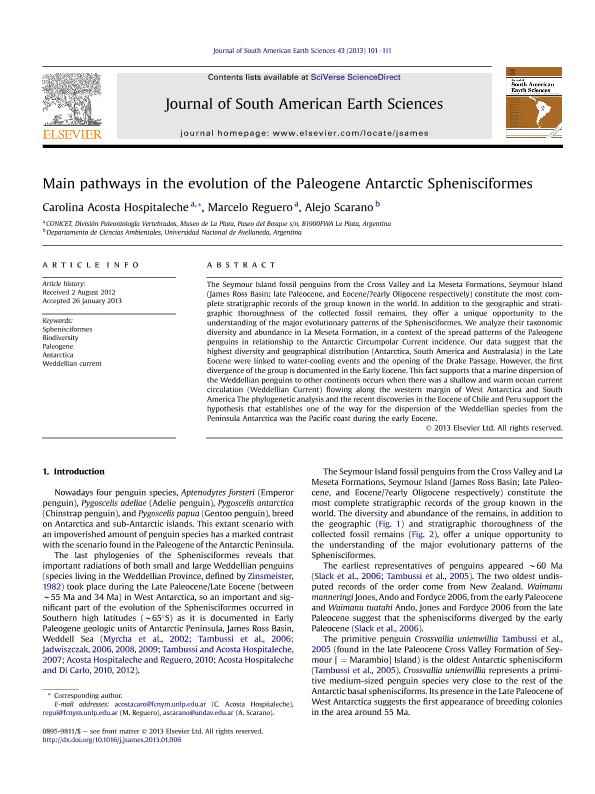Mostrar el registro sencillo del ítem
dc.contributor.author
Acosta Hospitaleche, Carolina Ileana Alicia

dc.contributor.author
Reguero, Marcelo Alfredo

dc.contributor.author
Scarano, Alejo Carlos

dc.date.available
2017-08-11T20:36:53Z
dc.date.issued
2013-04
dc.identifier.citation
Acosta Hospitaleche, Carolina Ileana Alicia; Reguero, Marcelo Alfredo; Scarano, Alejo Carlos; Main pathways in the evolution of the Paleogene Antarctic Sphenisciformes; Elsevier; Journal of South American Earth Sciences; 43; 4-2013; 101-111
dc.identifier.issn
0895-9811
dc.identifier.uri
http://hdl.handle.net/11336/22263
dc.description.abstract
The Seymour Island fossil penguins from the Cross Valley and La Meseta Formations, Seymour Island (James Ross Basin; late Paleocene, and Eocene/?early Oligocene respectively) constitute the most complete stratigraphic records of the group known in the world. In addition to the geographic and stratigraphic thoroughness of the collected fossil remains, they offer a unique opportunity to the understanding of the major evolutionary patterns of the Sphenisciformes. We analyze their taxonomic diversity and abundance in La Meseta Formation, in a context of the spread patterns of the Paleogene penguins in relationship to the Antarctic Circumpolar Current incidence. Our data suggest that the highest diversity and geographical distribution (Antarctica, South America and Australasia) in the Late Eocene were linked to water-cooling events and the opening of the Drake Passage. However, the first divergence of the group is documented in the Early Eocene. This fact supports that a marine dispersion of the Weddellian penguins to other continents occurs when there was a shallow and warm ocean current circulation (Weddellian Current) flowing along the western margin of West Antarctica and South America The phylogenetic analysis and the recent discoveries in the Eocene of Chile and Peru support the hypothesis that establishes one of the way for the dispersion of the Weddellian species from the Peninsula Antarctica was the Pacific coast during the early Eocene.
dc.format
application/pdf
dc.language.iso
eng
dc.publisher
Elsevier

dc.rights
info:eu-repo/semantics/openAccess
dc.rights.uri
https://creativecommons.org/licenses/by-nc-sa/2.5/ar/
dc.subject
Sphenisciformes
dc.subject
Biodiversity
dc.subject
Paleogene
dc.subject
Antarctica
dc.subject
Weddellian Current
dc.subject.classification
Oceanografía, Hidrología, Recursos Hídricos

dc.subject.classification
Ciencias de la Tierra y relacionadas con el Medio Ambiente

dc.subject.classification
CIENCIAS NATURALES Y EXACTAS

dc.title
Main pathways in the evolution of the Paleogene Antarctic Sphenisciformes
dc.type
info:eu-repo/semantics/article
dc.type
info:ar-repo/semantics/artículo
dc.type
info:eu-repo/semantics/publishedVersion
dc.date.updated
2017-08-07T16:39:09Z
dc.journal.volume
43
dc.journal.pagination
101-111
dc.journal.pais
Países Bajos

dc.journal.ciudad
Ámsterdam
dc.description.fil
Fil: Acosta Hospitaleche, Carolina Ileana Alicia. Universidad Nacional de la Plata. Facultad de Ciencias Naturales y Museo. División Paleontología Vertebrados; Argentina. Consejo Nacional de Investigaciones Científicas y Técnicas; Argentina
dc.description.fil
Fil: Reguero, Marcelo Alfredo. Universidad Nacional de la Plata. Facultad de Ciencias Naturales y Museo. División Paleontología Vertebrados; Argentina. Consejo Nacional de Investigaciones Científicas y Técnicas; Argentina
dc.description.fil
Fil: Scarano, Alejo Carlos. Universidad Nacional de Avellaneda; Argentina. Consejo Nacional de Investigaciones Científicas y Técnicas; Argentina
dc.journal.title
Journal of South American Earth Sciences

dc.relation.alternativeid
info:eu-repo/semantics/altIdentifier/doi/http://dx.doi.org/10.1016/j.jsames.2013.01.006
dc.relation.alternativeid
info:eu-repo/semantics/altIdentifier/url/http://www.sciencedirect.com/science/article/pii/S0895981113000230
Archivos asociados
